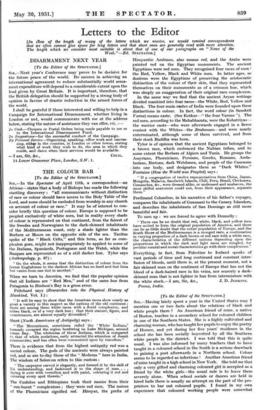THE COLOUR BAR
[To the Editor of the SvEcraron.]
Sia,—In the Spectator of April 11th, a correspondent—an Afrieantates that a body of Bishops has made the following startling discovery : "all communicants without distinction of race or colour should have access to the Holy Table of the Lord, and none should be excluded from worship in any church on account of colour or race." It may be of interest to con- sider briefly this question of colour. Europe is supposed to be peopled exclusively of white men, but in reality every shade of colour is represented on that continent, from the fairest of the Swedes and Norwegians to the dark-skinned inhabitants of the Mediterranean coast, only a shade lighter than the Berbers or Moors on the opposite side of the sea. Tacitus spoke of the " Black Celts,". and this term, as far as com- plexion goes, might not inappropriately be applied to some of the Italians, Spaniards, Portuguese and the Welsh, while the Basques are represented as of a still darker hue.. Tylor says (Anthropology, p. 67) :
" On the whole, it seems that the distinction of colour from the fairest Englishmen to the darkest African has no hard and fast lines but varies from one tint to another."
When • we turn to America, we find that the popular opinion that all Indians_ are "- Red, Men," and of the same hue from Patagonia to Hudson's Bay is a gross error.
Pritchard says (Researches into the Physical . History of Mankind, Vol.. I.).: "It will be easy to show that the American races show nearly as great. a variety in this respect as the nations of the old continent ; theie are among them white races with a florid complexion, and tribes black, or of a Very dark hue ; that their stature, flguie, and countenance,. are almost equally diversified." . • • - Shoit:(Ncrrth. Americans of Antiquity) says : • "The Menominees, sometimes Chile& the White Indians,i formerly occupied the- region bordering on Lake Michigan; around Green Bay. The whiteness of the se Indians, which is compared to that of wliite mulattoes, early attracted the attention of Jesuit inissiontriej; 'and has often been commented'upon-by travellers;" There is evidence that from the highest antiquity red was a. . , sacred Colour., The gods .of the ancients were always painted red,. and so are to-day those of the " Modems " here in India. The wisdom of Solomon refers to this custom : " The carpenter carved it -elegantly, .and formed it by the.skill of his Understanding, and fashioned it to the shape of man . . . laying it over with vermilion and with paint, colouring it red. and
covering every spot therein." - -
The -Cushites and -Ethiopians took their names from their " sun-burnt " complexions ; they -Were red men. -The names of the • Phoehibiana signified red. Himyar, the prefix of Himyaritic Arabians, -also means red, and the Arabs were painted red on the Egyptian monuments. The ancient Egyptians were red men. They recognized four races of men the. Red, Yellow, Black and White men. In latter ages, so
desirous were the Egyptians of preserving the aristocratic distinction of the colour of their skin, that they represented themselves on their monuments as of a crimson hue, which was simply an exaggeration of their original race complexion.
In the same way we find that the ancient Aryan writings divided mankind into four races—the White, Red, Yellow and Black. The four main castes of India were founded upon these distinctions in colour. In fact, the word colour (in Sanskrit Varna) means caste. (See Ketkar—" the four Varnas "). The red men, according to the Mahabharata, were the Kshatriyas- the warrior caste—who were afterwards engaged in a fierce contest with the Whites—the J3rahmans—and were nearly exterminated, although some of them survived, and from their stock Buddha was born.
Tylor is of opinion that the ancient Egyptians belonged to a brown race, which embraced the Nubian tribes, and to some extent the Berbers of Algiers and Tunis. He groups the Assyrians, Phoenicians, Persians, Greeks, Romans, Anda- lusians, Bretons, dark Welshmen, and people of the Caucasus
■ into one body, and designates them as "Dark Whites." Fontaine (How the World was Peopled) says :
" If a congregation of twelve representatives from China, Japan, Mongolia, Malacca, Sandwich Islands, Chili, Peru, Brazil, Chicksaws, Comanches, &c., were dressed alike, or undressed and unshaven, the most skilful anatomist could not, from their appearance, separate them."
Ferdinand Columbus, in his narrative of his father's voyages, compares the inhabitants of Guanaani to the Canary Islanders, and describes the inhabitants of San Domingo as still more beautiful and fair.
To sum up : we are forced to agree with Donnelly :
" There can be no doubt that red, white, black, and yellow men have united to form the original population of America, and there can be as little doubt that the entire population of Europe, and the South Shore of the Mediterranean is a mongrel race, a continuation in varying proportion of a dark brown or red race with a white race, the characteristics of the different nations depending upon the proportions in which the dark and light races are mingled, for peculiar mental and moral characteristics go with their complexions."
Everything, in fact, from Palestine to Iceland speaks of vast periods of time and long continued and constant- inter: fusion of bloods, until there is, at the present moment, not a fair skinned man on the continent of Europe that has not the blood of a dark-haired race in his veins, nor scarcely a dark- skinned man that is not lighter in hue from intermixture with






































 Previous page
Previous page